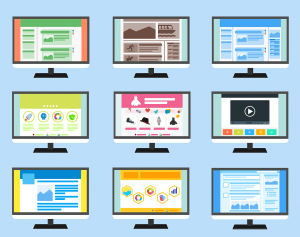In the rapidly evolving digital landscape, staying updated with the latest web technology trends is not just important, it’s essential. Why, you ask? Let’s delve into it.
Web technology is the backbone of all online experiences. Whether it’s a dynamic website, a cutting-edge mobile app, or an engaging social media platform, web technology makes it possible. It’s the engine that powers the internet.
But like any engine, it’s constantly evolving. New technologies emerge, old ones get updated, and trends shift. And in this fast-paced world, staying updated is crucial. It’s like keeping your engine tuned for optimal performance.
Staying updated with the latest trends allows you to leverage new technologies, tools, and practices. It can help you create more engaging experiences, reach a wider audience, and stay ahead of the competition. It’s about being proactive, not reactive.
So, whether you’re a web developer, a business owner, or just a tech enthusiast, staying updated with the latest web technology trends is a must. It’s not just about knowing what’s new. It’s about understanding how these trends can shape the future of the web, and how you can leverage them to your advantage.
In this article, we’ll explore some of the latest trends in web technology. From Progressive Web Apps to API-first design, we’ll delve into what’s hot in the world of web tech. So, buckle up and get ready for an exciting journey into the future of the web!
The Rise of Progressive Web Apps (PWAs)
Let’s dive into the world of Progressive Web Apps (PWAs), a rising trend in web technology.
PWAs are web applications that use modern web capabilities to deliver an app-like experience to users. They combine the best of both worlds - the flexibility and reach of the web with the user experience of a native app. PWAs can be installed on your device, work offline, and send push notifications, just like native apps. But unlike native apps, they’re not tied to specific platforms and don’t need to be downloaded from app stores. This makes them more accessible and easier to update.
So, why are PWAs trending? The answer lies in their unique advantages. PWAs offer a seamless, integrated user experience. They load quickly, work on any platform, and can be accessed from anywhere. This makes them ideal for businesses looking to reach a wider audience without the constraints of platform-specific apps.
Moreover, PWAs are more efficient and cost-effective than native apps. They’re easier to develop and maintain, as they use a single codebase for all platforms. They also take up less storage space on devices, making them more user-friendly.
Examples of Successful PWAs.
Now, let’s look at some examples of successful PWAs. Twitter Lite is a PWA that offers a faster, more data-efficient version of Twitter. It has significantly increased user engagement and reduced bounce rates. Another example is Starbucks’ PWA, which allows customers to browse the menu, customize their orders, and add items to their cart, all while offline. This has led to a significant increase in daily active users.
In this regard, the rise of PWAs represents a shift in web technology. They offer a more efficient, accessible, and user-friendly alternative to native apps. As more businesses recognize these benefits, the trend towards PWAs is set to continue. So, whether you’re a web developer or a business owner, it’s worth exploring what PWAs can do for you.
Web Technology’s Single Page Applications (SPAs)
Let’s explore the world of Single Page Applications (SPAs), a trend that’s reshaping the web development landscape.
SPAs are web applications that load a single HTML page and dynamically update that page as the user interacts with the app. Unlike traditional multi-page websites that reload the entire page when you navigate, SPAs only update the part of the page that changes. This results in a smoother, faster, and more app-like user experience.
So, why are SPAs becoming popular? The answer lies in their unique advantages. Firstly, SPAs offer a seamless user experience. There are no page reloads, which means transitions between different parts of the application are smooth. Secondly, SPAs are faster. Since they only load the necessary content, they can significantly reduce load times. Lastly, SPAs are easier to debug with Chrome, as you can monitor network operations, investigate page elements and data associated.
Now, let’s look at some examples of well-known SPAs. Gmail, Google Maps, and Facebook are all examples of SPAs. These applications load once and then dynamically update the page based on user interaction. This results in a fast, seamless user experience.
Web Technology As Applied By Gmail, Google Maps, and Facebook
Gmail
When you log into your Gmail account, the entire application loads once. As you click on different emails or navigate to different folders, the page doesn’t reload. Instead, only the part of the page that needs to change is updated. This results in a fast, seamless user experience, making it easier to manage your emails.
Google Maps
Similarly, Google Maps is also a SPA. When you search for a location, the map doesn’t reload. Instead, it dynamically updates to display the searched location. This allows for smooth navigation and interaction, enhancing the user experience.
Facebook, one of the most popular social media platforms, is another example of a SPA. When you scroll through your news feed, the page doesn’t reload. Instead, new content is dynamically loaded as you scroll. This provides a seamless browsing experience, allowing you to stay engaged with the content.
These examples highlight the power of SPAs in creating fast, seamless, and interactive user experiences. By dynamically updating the page based on user interaction, SPAs eliminate the need for page reloads, resulting in a smoother and more enjoyable user experience. This is why they are becoming increasingly popular in web development, and why more and more businesses are adopting this approach for their websites and web applications.
As such SPAs represent a shift in web development. They offer a more efficient, user-friendly alternative to traditional multi-page websites. As more developers recognize these benefits, the trend towards SPAs is set to continue. So, whether you’re a web developer or a business owner, it’s worth exploring what SPAs can do for you.
API-First Design Approach- Web Technology
API-first design, also known as API-driven development, is an approach to software development where you start with the API (Application Programming Interface) before building the rest of your application. This is a shift from the traditional approach where the API is usually an afterthought, built after the application is complete.
So, why is API-first design becoming a trend? The answer lies in its numerous benefits.
- Consistency: With API-first design, you ensure consistency across multiple platforms (web, mobile, IoT devices, etc.). Since the API is built first, all platforms use the same API, leading to a consistent user experience across all devices.
- Efficiency: API-first design can lead to increased efficiency. Developers can work on the frontend and backend simultaneously, as they both rely on the same API. This can significantly reduce the development time.
- Scalability: API-first design allows for easy scalability. As your application grows, you can easily add more resources to your API without affecting the frontend.
- Future Proofing: With API-first design, you’re better prepared for future technological advancements. As new platforms emerge, you can easily integrate them with your existing API.
A great example of API-first design is Twitter. When Twitter decided to rebuild their platform in 2010, they adopted an API-first approach. They built their API before developing the frontend. This allowed them to ensure consistency across web and mobile platforms, increase development efficiency, and prepare for future platforms.
API-first design is indeed a growing trend in web technology due to its numerous benefits. It offers a more efficient, scalable, and future-proof approach to software development. So, whether you’re a web developer or a business owner, it’s worth exploring what API-first design can do for you.
Motion UI Web Technology
Motion UI, or Motion User Interface, is a design trend that’s gaining popularity in the web development world. It involves the use of animations and transitions to enhance the user experience on a website or app.
So, what makes Motion UI impactful? The answer lies in its ability to guide users. Motion UI can direct attention, provide feedback, and enhance the overall aesthetic of a website or app. It can make a digital product feel more alive and interactive. For example, a button might bounce when clicked, or a menu might slide in from the side. These animations can make the user experience more enjoyable and intuitive.
Moreover, Motion UI can improve usability. Animations can guide users through a process, highlight changes, or indicate loading times. This can make a website or app easier to use and understand.
Popularity of Motion UI Web Technology
But why is Motion UI becoming popular? As web technologies advance, developers are finding new ways to enhance user experiences. Motion UI is one of these ways. It allows developers to create more engaging, interactive, and user-friendly digital products.
A great example of Motion UI is the website for the movie “Spider-Man: Into the Spider-Verse”. The website uses a variety of animations and transitions to create an immersive and engaging user experience. As you scroll through the site, elements slide in and out, change size, and even rotate. This creates a dynamic and interactive experience that’s reflective of the movie’s innovative animation style.
In this regard, Motion UI can be observed to be a powerful tool for enhancing user experiences. By using animations and transitions, developers can create more engaging, interactive, and user-friendly websites and apps.
Accelerated Mobile Pages (AMPs) and Mobile-First Indexing
In the era of smartphones, the need for faster loading speeds on mobile devices is more crucial than ever. Users expect quick, seamless experiences when browsing the web on their phones. This is where Accelerated Mobile Pages (AMPs) and Mobile-First Indexing come into play.
Accelerated Mobile Pages (AMPs) is an open-source project designed to make mobile pages load faster. AMPs are stripped-down versions of regular web pages. They use a simplified version of HTML and a limited set of JavaScript functionality to ensure rapid loading. AMPs also get cached by Google, allowing them to be served more quickly to users. The result? Faster page loading, less data usage, and a better user experience on mobile devices.
On the other hand, Mobile-First Indexing is a shift in how Google ranks websites. Traditionally, Google’s crawling, indexing, and ranking systems have used the desktop version of a page’s content. However, with the majority of users now accessing Google Search with a mobile device, Google has switched to mobile-first indexing. This means Google predominantly uses the mobile version of the content for indexing and ranking.
The shift to Mobile-First Indexing underscores the importance of ensuring your website is mobile-friendly. It’s not just about loading speed, but also about how well your content is presented on mobile devices. Websites that provide a better mobile experience will have a significant advantage in Google’s search results.
It’s worth noting that both AMPs and Mobile-First Indexing highlight the growing importance of mobile optimization in web technology. As more users turn to their smartphones for web browsing, developers must prioritize mobile performance and user experience.
Voice Search Optimization Web Technology
Voice search optimization is becoming increasingly important in the world of SEO. With the rise of smart speakers and voice assistants like Alexa, Siri, and Google Assistant, more and more people are using voice search to find information online.
So, why is voice search optimization important? The answer lies in the unique characteristics of voice search. Voice searches are typically longer and more conversational than text searches. They often involve full sentences or questions, rather than just keywords. This means that websites need to be optimized for these longer, more natural language queries to rank well in voice search results.
Moreover, voice search is often used for local searches. People might use voice search to find a nearby restaurant, shop, or service. This means that local SEO is particularly important for voice search optimization.
How to Optimize Your Website for Voice Search Web Technology
So, how can you optimize your website for voice search? Here are some tips:
- Use Long-Tail Keywords: Since voice searches are often longer and more conversational, long-tail keywords can be effective for voice search optimization. These are longer, more specific keyword phrases that visitors are more likely to use when they’re closer to a point-of-purchase or when they’re using voice search.
- Optimize for Local Search: If you’re a local business, make sure your website is optimized for local search. This includes having a Google My Business listing, using local keywords, and having up-to-date contact information on your website.
- Create FAQ Pages: Voice searches often involve questions. By creating FAQ pages that answer common questions about your business or industry, you can increase your chances of ranking well in voice search results.
- Make Your Website Mobile-Friendly: Many voice searches happen on mobile devices. Having a mobile-friendly website is crucial for ranking well in voice search results.
Voice search optimization is a growing trend in SEO. By understanding the unique characteristics of voice search and implementing these optimization strategies, you can stay ahead of the curve and ensure your website ranks well in voice search results.
Artificial Intelligence and Bots
Artificial Intelligence (AI) and bots are revolutionizing web technology and user interaction. Let’s delve into their role and how they enhance user interaction.
AI and bots are increasingly being used to automate and enhance user interactions on websites and apps. They can handle a variety of tasks, from answering customer queries to providing personalized recommendations.
- Customer Service Bots: Many websites now use AI-powered bots for customer service. These bots can answer common queries, provide information, and even help users navigate the website. This not only improves the user experience but also frees up human customer service agents to handle more complex issues.
- Personalized Recommendations: AI can analyze a user’s behavior and preferences to provide personalized recommendations. This is commonly used in e-commerce websites and streaming platforms to enhance the user experience and increase engagement.
- Content Generation: AI can also generate content, such as news articles, reports, and even creative writing. This can help keep websites updated with fresh content, improving SEO and user engagement.
- Predictive Analysis: AI can analyze user behavior and predict future actions. This can help websites optimize their content and design to better meet user needs.
- Voice Assistants: AI-powered voice assistants like Siri, Alexa, and Google Assistant are becoming increasingly common. They can understand and respond to voice commands, making user interaction more seamless and natural.
It’s therefore worth noting that AI and bots are playing a crucial role in enhancing user interaction in web technology. They can automate tasks, provide personalized experiences, and even generate content. As AI technology continues to evolve, we can expect to see even more innovative applications in web technology.
Takeaways
We’ve journeyed through the latest trends in web technology, exploring how each one is shaping the digital landscape. From the rise of Progressive Web Apps (PWAs) and Single Page Applications (SPAs), to the growing importance of API-first design and Motion UI, we’ve seen how these trends are enhancing user experiences and reshaping the way we interact with the web.
We’ve also delved into the world of Accelerated Mobile Pages (AMPs) and Mobile-First Indexing, understanding the need for faster loading speeds and better mobile optimization in an increasingly mobile world. We’ve also explored the role of Artificial Intelligence (AI) and bots in web technology, seeing how they can automate tasks, provide personalized experiences, and even generate content.
These trends highlight the rapid evolution of web technology and the importance of staying updated. For businesses, these trends offer new ways to reach and engage with their audience, improve their online presence, and stay ahead of the competition. For web developers, these trends present new challenges and opportunities for innovation.
In conclusion, staying updated with the latest trends in web technology is not just important, it’s essential. It’s about being proactive, not reactive. It’s about understanding the direction in which the digital world is moving and positioning yourself to move with it. So, whether you’re a business owner or a web developer, make sure you’re keeping up with the latest trends in web technology. The future is here, and it’s online.










